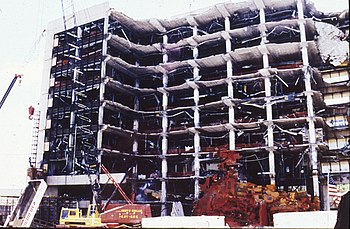Oklahoma City bombing
The Oklahoma City bombing struck the Alfred P. Murrah Federal Building in Oklahoma City, OK on April 19, 1995, killing 168 people (including 19 children) and wounding more than seven hundred other people. The explosion also damaged other nearby structures. Federal agencies housed in the building included the Bureau of Alcohol, Tobacco, and Firearms (ATF); the Drug Enforcement Administration (DEA); the Secret Service; the U.S. Department of Housing and Urban Development; the U.S. Social Security Administration; U.S. Army and [United States Marine Corps]] recruiting offices, the Veterans Administration; the General Accounting Office; the U.S. Department of Health and Human Services; the U.S. Department of Defense; the U.S. Customs Service; the U.S. Department of Agriculture; the U.S. Department of Transportation and, the U.S. General Services Administration. There was also a private childrens' day-care center there.
The bomb was set off by Timothy McVeigh, a U.S. citizen with a virulent hatred of the American government, with background help by a man named Terry Nichols. The bombing produced the heaviest casualty count of any terrorist incident in the U.S. before the 9/11 attacks. McVeigh's greatest anger seemed to be against ATF, which he thought was headquartered there. [1] McVeigh alone placed the truck containing the bomb, although he had one collaborator, Nichols, in fabricating it.
Emergency response
Oklahoma City's fire department was the lead agency, and immediately invoked the Incident Command System.[2] A Forward Command Post was placed inside the interior loading dock of the Murrah Building. Adding to the complexity of operations was that the Federal Bureau of Investigation immediately designated it a crime site. The Joint Command(JOC) function was placed at the State Emergency Operations Center (SEOC), 3 miles from the incident. Emergency management personnel had been in a nearby meeting, so the SEOC was operating at 9:25 AM, after receiving an initial notification at 9:04. The Federal Emergency Management Agency (FEMA) was notified at 9:30 and activated their Regional Operations Center in Denton, Texas; the regional director arrived at the SEOC at 14:05, and the FEMA Director, James Witt, at 20:10.
The explosion taxed local resources to their limits, at the edge of a mass casualty incident. Some victims almost certainly survived the explosion but died before they could be extricated; certain areas were too structurally unstable for an immediate approach by rescuers. Some trapped victims needed to have limbs amputated, without anesthesia, to be removed from wreckage. The last survivor was removed at 22:05; national urban search and rescue teams began arriving at 22:45, and participated in the recovery building.
Of the surviving victims, secondary blast injuries from fragments were the most common. Approximately 20% of these victims died. [3]
Complementing the JOC, a Multi-Agency Coordination Center (MAC) was set up on the 21st at a nearby convention center; this was the point of contact for the press.
Perpetrators and response
McVeigh was arrested for a traffic violation approximately 90 minutes after the blast. The reasons for the attack were never totally clear, although McVeigh and Nichols appear to have had revenge for the Federal raid on the Branch Davidians in Waco, Texas. They were influenced by militant groups generally characterized as of the extreme right; the incident has some parallels to events in a novel, The Turner Diaries.
A defense motion for a potentially less biased venue was accepted, and the trial moved to Denver, Colorado. Jury selection began in March 1997.[4] Janet Napolitano, then Secretary for Homeland Security and a United States Attorney, directed the Federal prosecution, which sentenced McVeigh to death; he was later executed.
Conspiracy theories
As with many major national incidents, a number of conspiracy theories have come into existence regarding the attack and the FBI investiagion that followed. These include accusations of a link between McVeigh and the Elohim City white nationalist compound, and accusations that the federal authorities knew of McVeigh's plans and pulled out FBI and ATF agents, leaving only civilian workers.[5]
Early after the blast, Steven Emerson reported that it had the signature of Islamist terrorism; he was not the only person making such totally unsubstantiated and incorrect allegations.
References
- ↑ Jo Thomas (25 April 1997), "Trial Begins in the Oklahoma City Bombing Case", New York Times
- ↑ After Action Report: Alfred P. Murrah Federal Building Bombing, Oklahoma Department of Civil Emergency Management
- ↑ Mallonee S, et al. (7 August 1996), "Physical injuries and fatalities resulting from the Oklahoma City bombing", JAMA 276(5): 382-7.
- ↑ Jim Lehrer (31 March 1997), "Setting the Stage", Online Newshour, PBS
- ↑ Thirty Oklahoma City Bombing Questions That Demand An Answer Now! and Steven Yates, The Oklahoma City Bombing: A Morass of Unanswered Questions on LewRockwell.com.
